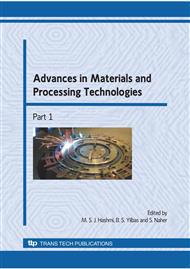p.1076
p.1084
p.1092
p.1099
p.1107
p.1113
p.1121
p.1129
p.1135
Theoretical, Numerical and Experimental Investigation of the Effects of Manufacturing Process Parameters on Thin-Walled Tube Bending Defects
Abstract:
The aim of this paper is to survey thin-walled tube bending process (without use of mandrel and booster). In tube bending process there are several effective parameters such as wall thickness, outer diameter-to-wall thickness ratio, and centerline bending radius-to-outer diameter ratio. Any mismatch in selecting these parameters would cause defects like wrinkling, variation in wall thickness, and cross section distortion. Firstly, the effects of these parameters on the initiation of the wrinkle, depth of wrinkling, change in wall thickness, and cross section distortion are studied. For this purpose, an FE commercial code has been used to simulate the process. Then, a series of experimental tests have been carried out to verify the results simulation. A comparison between analytical and experimental results shows a reasonable agreement with each other. Based on this comparison, it has been observed that there is a critical bending radius for any tube with a certain radius and thickness, in which the wrinkling begins to occur. For a certain bending angle and radius, it have been observed that the depth of wrinkling, change in wall thickness, and cross section distortion increase with reduction in wall thickness and outer diameter-to-wall thickness ratio
Info:
Periodical:
Pages:
1107-1112
Citation:
Online since:
December 2009
Authors:
Keywords:
Price:
Сopyright:
© 2010 Trans Tech Publications Ltd. All Rights Reserved
Share:
Citation:


